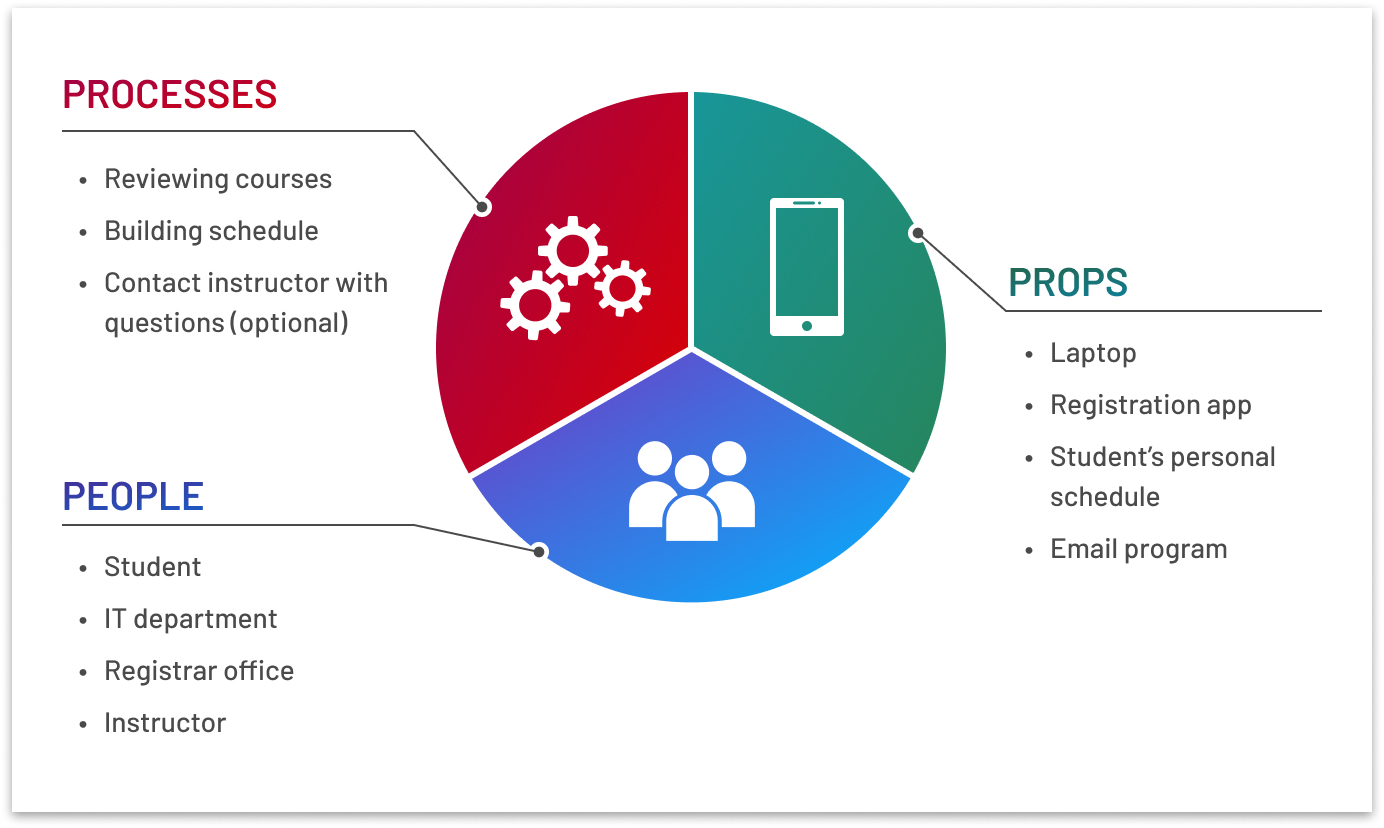For your EdTech product to be as valuable as possible, it’s important to meet users where they are. But what if you don’t know exactly where that is? How can you develop new products that meet their needs? Or successfully maintain products that continue to do so?
UX research exposes areas where users may experience frustration within your product. Many times, though, additional challenges happen adjacent to the use of your product — outside the product itself. However, these obstacles can still impact the use of your product.
Understanding the ecosystem of instructors and students sheds light on how your product fits into their overall experience. Service design thinking will get you there. While you may be familiar with the principles of service design, you probably haven’t thought about it within the context of your EdTech product.
Service design looks beyond your product to consider the full experience of your users. Any experience — class registration, a hotel stay, a DMV visit — can be better understood by examining the relationship and dependencies of all the steps and tools involved.
Since you’re in the business of building products that solve problems for instructors and students, you should be thinking about how your product fits into the overall user experience. By applying service design principles, you can better understand challenges your users face and develop and maintain products that solve the most relevant problems in ways that only your product can.
Service Design Considers the Big Picture
Your product is just one piece of the educational experience for instructors and students. Understanding how it fits — along with any outside influences impacting its use — is an important step to building a product roadmap that addresses current and future needs of your users.

Service design looks at each element of the user experience in a holistic way, focusing specifically on the three Ps.
- Processes are the steps or workflows within an experience. This includes the actions of your primary user as well as actions taken by others who support them in the process. In a class registration scenario, user-centered processes include reviewing courses on the website, building a schedule online or emailing an instructor with a question. Service design also acknowledges any “backstage” processes that enable or enhance the experience. In the registration process, backstage processes could include building the online catalog or sending a confirmation email.
- People are everyone involved at any point during the experience — the individuals going through the processes, anyone they interact with and anyone involved in the backstage processes described earlier. Returning to our registration scenario, people would encompass the student, the IT department of the university, the representative in the registrar’s office and the instructor.
- Props refer to the physical or digital components any person needs to complete a process — products, space, etc. Items like a laptop, a registration app, a student’s personal schedule, or an email program would be relevant to the registration experience.
When applied to EdTech, this full experience view illuminates the reality that your product is part of a bigger picture. Once you understand the factors influencing your users, you can make decisions to make your product more valuable.
UX Tools Can Be Applied to Service Design
Good EdTech products incorporate UX into the development process. But product owners wanting to secure a competitive advantage for their product in the future will also incorporate service design thinking. The good news is that UX and service design are complementary disciplines.
A good UX team is well-versed in UX design and research methodologies. While they typically use these tactics at the product level, similar approaches can be applied to understand high-level service design scenarios.
User journey maps and service design blueprints

As part of UX research, we often create journey maps to document a user’s path as they use a product. Service design has an equivalent service blueprint. The service design blueprint includes elements of the user journey but also incorporates the supporting steps and inputs. In other words, it visualizes the breadth of processes, people and props required to achieve each step on the journey.
UX research and collaboration

The goals of service design are to identify and solve pain points in a process while building value for the user — much like the goals of UX at the product level.
The same UX research framework used to uncover additional information about your product can be used to establish optimal conditions for the total experience. Rather than digging into specifics about your product, though, you’ll use the research methods (co-creation sessions, contextual interviews, etc.) to understand the processes, people and props at a higher level and how your product fits.
Like UX at the product level, service design research should be collaborative. Cross-functional teams and stakeholders representing all the people involved in the experience will be crucial for success. The more representation included early in the process, the more likely you are to identify common problems and potential solutions.
Service Design Leads to a Better EdTech Product
When you’re considering the full ecosystem, product development efforts can focus on the features that your users need (and not waste time developing capabilities they are getting elsewhere).
A common example is gradebooks. Grades are important to the learning experience. But when considered in the context of the learning ecosystem, your product’s gradebook likely isn’t the endpoint. Instead, instructors are exporting final grades from your product into a different system.
Consider, then, how the overall service experience is impacted for instructors using multiple EdTech products in their classrooms. Gradebooks in different products can function differently and meet different needs for both instructors and their institutions. Focusing solely on your gradebook functionality without consideration of impacts outside your product may introduce unnecessary frustration. An instructor needs to learn yet another system and create a workaround for moving grades to an alternate system.
But by considering the full ecosystem, you might determine you need only build an effective export feature. The instructor can still track grades within your product, however now they can easily move them to the university’s grading system. By simplifying the feature (but still meeting the needs of your user), your product team has capacity to focus on more impactful features that will deliver more value.
It’s a natural tendency of curious researchers and developers to want to solve every problem with a product. But your product exists within a larger context. When you think strategically about what problems your product is capable of solving and what problems can (or should) be solved outside of your product, your product can be more innovative.
Service Design Increases Your Understanding of Your Users
Perhaps you’ve been focused on solving a particular problem, but it’s not important to your users. Or maybe the way you’re solving a problem doesn’t have the greatest impact due to the constraints of your digital product. Service design thinking will expose these areas of misalignment and reveal new opportunities your product may be able to address.
Service design encourages product teams to put users and their needs at the forefront of the story. It recognizes the array of supporting characters (people) and things (props) they encounter on their path to completing what they need to do (processes). The combination of big-picture service design thinking and robust UX research efforts will result in true differentiation for your product.
